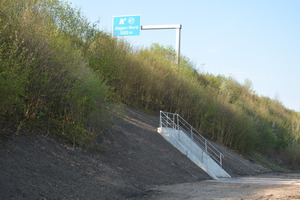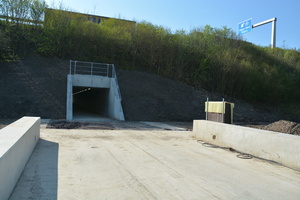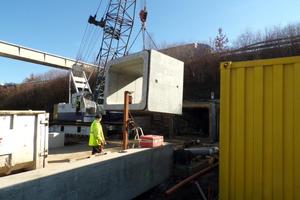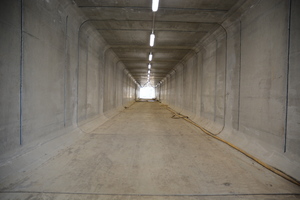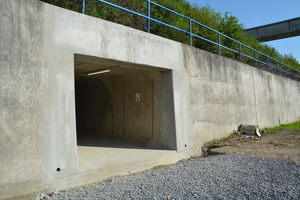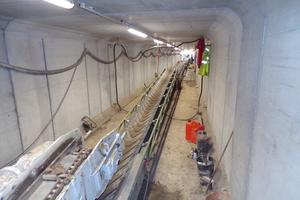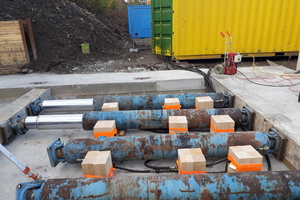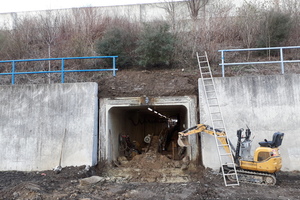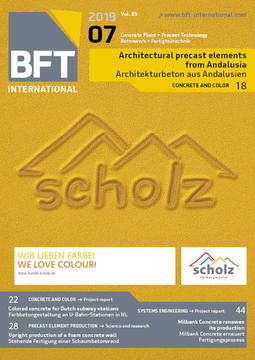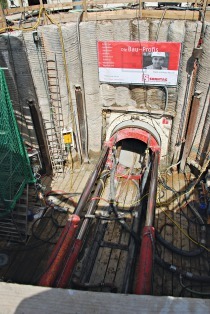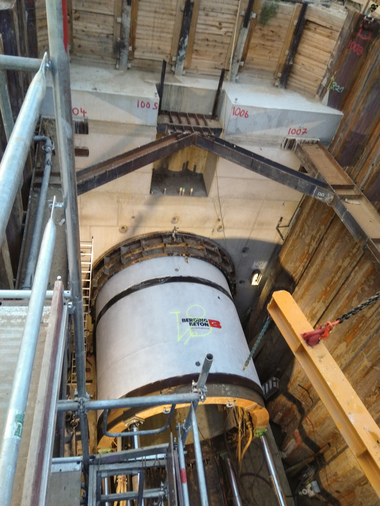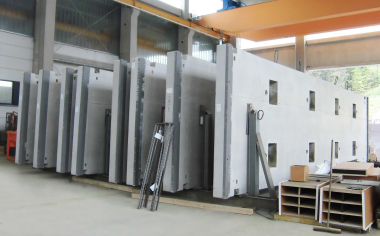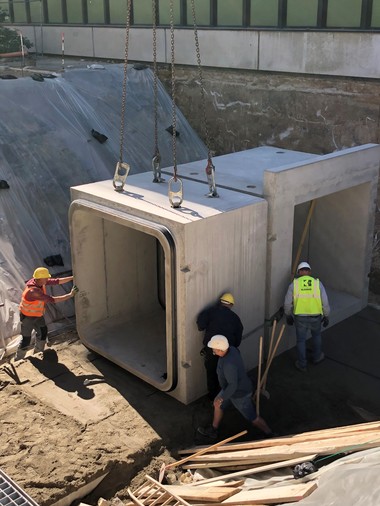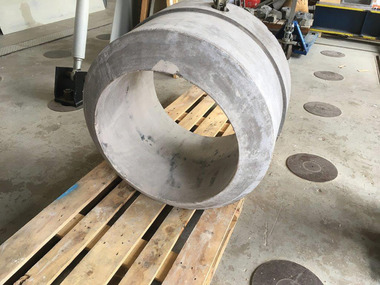Media tunnel of reinforced-concrete frames jacked below the A 1 expressway near Hagen, Germany
In recent years, trenchless pipe jacking of reinforced-concrete pipes has reached an advanced technical level, as a result of international research and development work. One of the latest project involves the new construction of a media tunnel in Hagen, Germany, which the precast plant Betonwerk Kleinhues of Emsbüren, Germany, jacked through the A1 federal expressway embankment.
In recent years, trenchless jacking of reinforced-concrete pipes has reached an advanced technical level, as a result of international research and development work. Today, it is a field-tested alternative to open-cut construction. Until now, however, circular pipes have been primarily used for this purpose, although many applications preferably specify rectangular structural components. The company Vortriebstechnik Weiss GmbH has for some time been using a method that enables jacking of rectangular cross-sections as well. The new construction of a media tunnel in Hagen, Germany, is the most recent project, in which Betonwerk Kleihues from Emsbüren, Germany, jacked a rectangular reinforced-concrete section below the embankment of the A1 expressway.
The paper manufacturer Kabel Premium Pulp & Paper GmbH, based in Hagen, Germany, is currently constructing on its company grounds a plant for fiber preparation of wood shavings. The distinctive feature: the company grounds are divided in two halves, almost exactly in the middle, by the A1 federal expressway. While the new plant is erected on the northern part of the site, the refiner-pulp produced in that plant will, in future, be moved to the southern part of the company grounds for further processing. This confronted the engineering consultancy Ingenieurbüro Bals of Hagen, Germany, which was commissioned with overall planning, and its planning partner the engineering consultancy Ingenieurbüro Heymer, Wetter (of Ruhr, Germany,) with the challenge of building a connecting tunnel below the A1 expressway for installation of the media pipelines required from the northern to the southern part of the site.
Difficult local situation
The high-pressure gas pipeline buried in the grounds posed another problem in planning and implementing the connecting tunnel. It was not possible to move the pipeline, to perform construction over it, or to expose it to compressive forces. “Following preliminary planning for different concepts, we decided on trenchless jacking with rectangular cross sections, even if this technique in the planned dimensions is rarely executed in Europe,” explained Dipl.-Ing. Stephan Bals of the engineering consultancy Ingenieurbüro Bals.
The partial section of the A1 expressway between Hagen North and Hagen West was built in the sixties on an embankment profile. The road embankment of the six-lane A 1 expressway has a height of approx. 9 to 10 m and a crown width of approx. 35 m. The width of the embankment base, of approx. 60 m, also approximately corresponded to the length of the media tunnel planned. The slope on the northern site is open; on the southern side, following subsequent widening of the expressway, it has been enclosed by a retaining wall of approx. 5 m. In addition, there exists on the northern side of the expressway a parallel high-pressure gas pipeline, located approx. 10 m in front of the bottom of the embankment and approx. 1.3 m below the upper edge of the existing grounds.
Cyclic jacking without blocking the A1 expressway
“For construction of the connecting tunnel, the technique of trenchless jacking of individual rectangular cross-sections was chosen. In this way, by jacking the rectangular precast concrete segments – measuring 4.20 m (width) x 3.50 m (height), a wall thickness of 35 cm and segment lengths of 2.50 m from Betonwerk Kleihues from Emsbüren, Germany – the tunnel was constructed without having to close the A1 expressway.
The construction took place by cyclic jacking of 23 precast concrete segments beginning at the northern side of the expressway embankment. On the two ends, special structures were built as support and/or integrated in the existing retaining wall. “The backfill height of the tunnel amounted here to between approx. 6 and 6.5 m,” as Dipl.-Ing. Stephan Bals explained the main basic conditions.
No abutment for taking up the jacking forces
The structural engineering consultancy Ingenieurbüro Ing.-Büro Heymer from Wetter (Ruhr), Germany, commissioned Dipl.-Ing. Jo Hartmann from the engineering consultancy Ingenieurbüro I-KIS in Olfen, Germany, with detail planning of the anchorage. He describes additional distinctive features of the procedure: “Since the tunnel connects at a point level with the site terrain bordering the embankment foot, neither a launch nor a reception pit was required. For that reason, there was also no jacking abutment in the construction pit, as can otherwise be made available for trenchless pipe jacking in activating the high passive earth forces to counteract the jacking forces. For this reason, a jacking-force abutment of the required strength had to be constructed on the north side.”
Reverse anchored reinforced-concrete jacking-force slab
“Owing to the special situation of the high-pressure pipeline, we favored a reverse-anchored reinforced-concrete jacking force-slab with deep-sunken jacking chambers for the jacking presses of the tunnel elements,” declared Jo Hartmann. In this way the jacking loads were prevented from acting on the pipeline.
“Before installing the anchors for the jacking abutment, both the provisional bridge and the reverse-anchored temporary lining were constructed in the area of the expressway embankment. The temporary bridge was constructed as a trough to keep the delivery vehicles on the bridge safe,” says Dipl.-Ing. Erich Heymer.
The next step was preparation of the foundation layer for the jacking abutment slab. This was followed by constructing the reverse anchorage of the jacking abutment slab. For optimal transmission of forces, the anchors were installed in a U-shaped, fanned orientation in the direction of jacking, and with an inclination of 30 ° into the bearing soil stratum and firmly anchored into the ground by means of pressure grouting. The anchor heads were positioned to lie around the press chambers of the jacking abutment slab below. Before casting the abutment slab, the steel tension members of the pressure-grouted anchors were provided with ducts and jacking chamber formwork at the anchor head. Following completion of the reinforced-concrete abutment slab, the specified loadbearing capacity of every pressure-grouted anchor in the ground was tested and confirmed.
Maximum anchor forces and subsoil pressure
In order to attain a horizontal jacking force of max. Ph = 6,000 kN, installation took place of 12 ground anchors with precisely aligned anchor inclinations and pivoting towards the jacking axis. The design anchor force here was max. Ak = 596.3 kN. The vertical anchor components resulting from the anchor inclination generated soil-pressure values below the abutment slab that were within the permitted range.
Owing to the broadening of the A1 expressway by one lane on both sides, it was necessary for design of the frame elements for various ground situations: for one, the subsoil of the actual old embankment and, secondly, the subsoil of the broaden area, the characteristics of which varied, according to subsoil expert opinion. The calculations were performed on the basis of the specifications of worksheet A 127 of the German Association for Water Management, Sewage and Waste (ATV-DVWk).
Jacking by the technique of Vortriebstechnik Weiss
Actual jacking was carried out by the company VTW Vortriebstechnik Weiss GmbH, from Hünxe, Germany, using a jacking system supported by the abutment on the one side and, on the other side, by the floor of the cross-section. Managing Director Dipl.-Ing. Benedikt Weiss explained the technique: “The abutment was provided with a guide of steel girders cast into the concrete, which positions the segments on the preceding segment in the correct vertical and horizontal positions.
The first segment to be jacked in was provided with a cutting shoe, which loosened the ground at the correct profile. The soil on the working face was extracted by a mini-excavator, which loosened the material and placed it on a conveyor belt for transport to the outside. “Since we encountered a soil layer of 1- to 2-cm thickness mixed with lime, we had to work here manually with a pick hammer in the traditional mining method,” said Weiss.
Hard ground: 1 m jacked per day
During jacking, larger whole blocks of ground repeatedly broke out. The resulting cavities were initially closed with a Bentonit suspension in the area between the precast reinforced-concrete components and the surrounding ground and, subsequently, with a cement injection. “Due to the particular ground conditions, we were able in this way to jack only about one meter a day,” says Benedikt Weiss. “Still, this project has demonstrated that jacking is also perfectly feasible with a rectangular profile – even under the most difficult conditions. Thanks to the precautionary measures we had taken, even the precast components weighing up to 33 tons and the jacking with 600 tons were not able to cause damage to the high-pressure gas pipeline.”
The new plant of Kabel Premium Pulp & Paper is scheduled go into operation in mid-2020 – or, at the latest, in the first quarter of 2021. After that, the paper manufacturer targets a processing capacity of around 100,000 tons of refiner pulp yearly – and the tunnel below the expressway would then also even be large enough to enable exceeding this this value.
CONTACT
Kleihues Betonbauteile GmbH & Co. KG
Zentralbüro
Siemensstraße 21
48488 Emsbüren/Germany
+49 5903 9303-0

